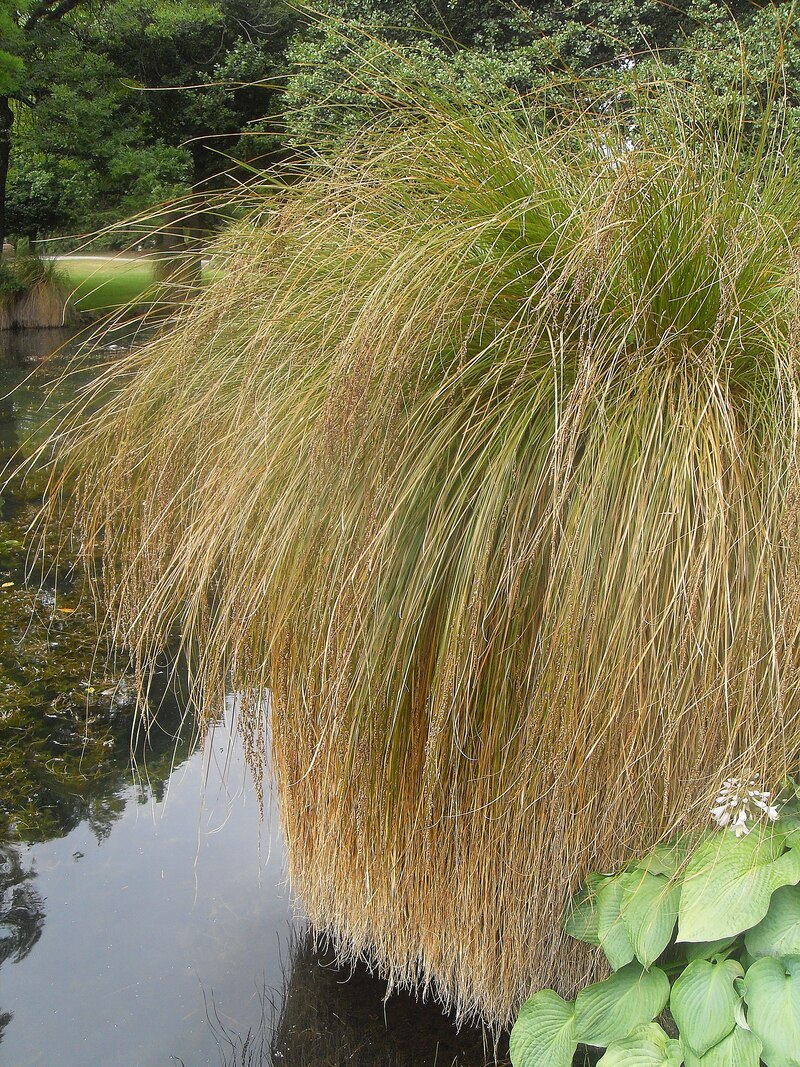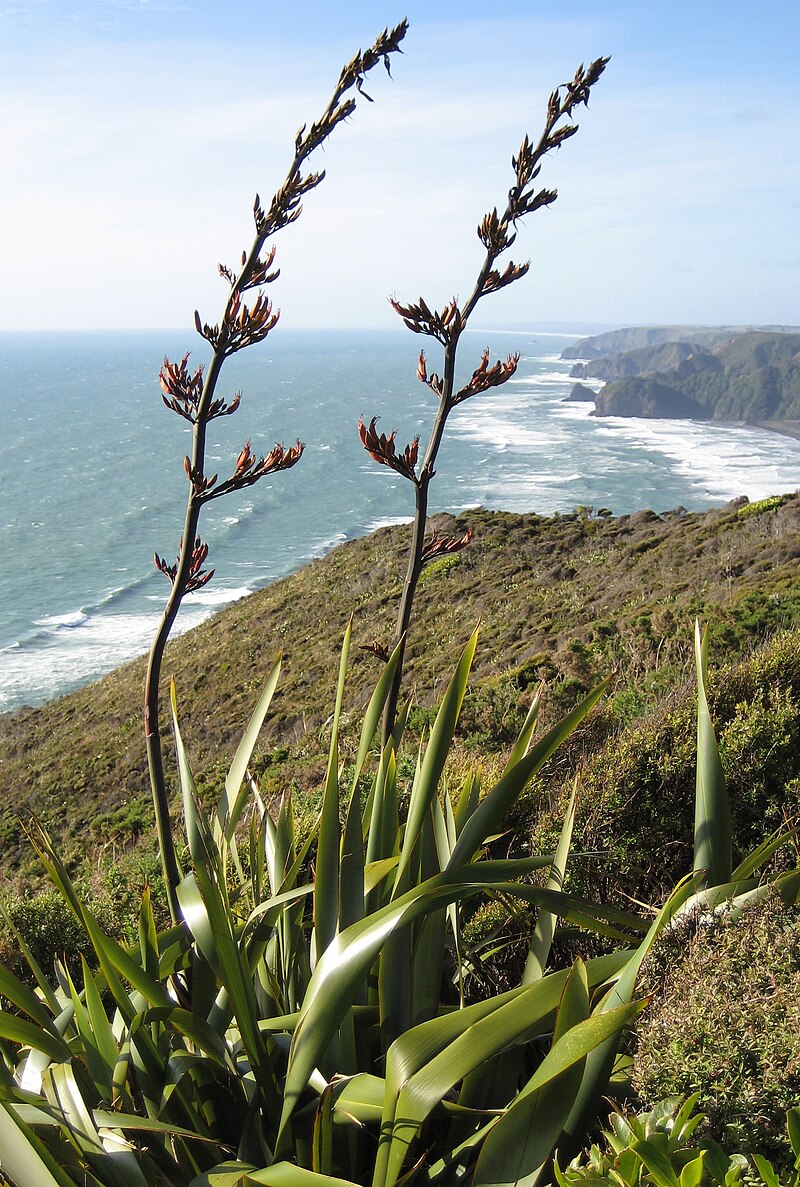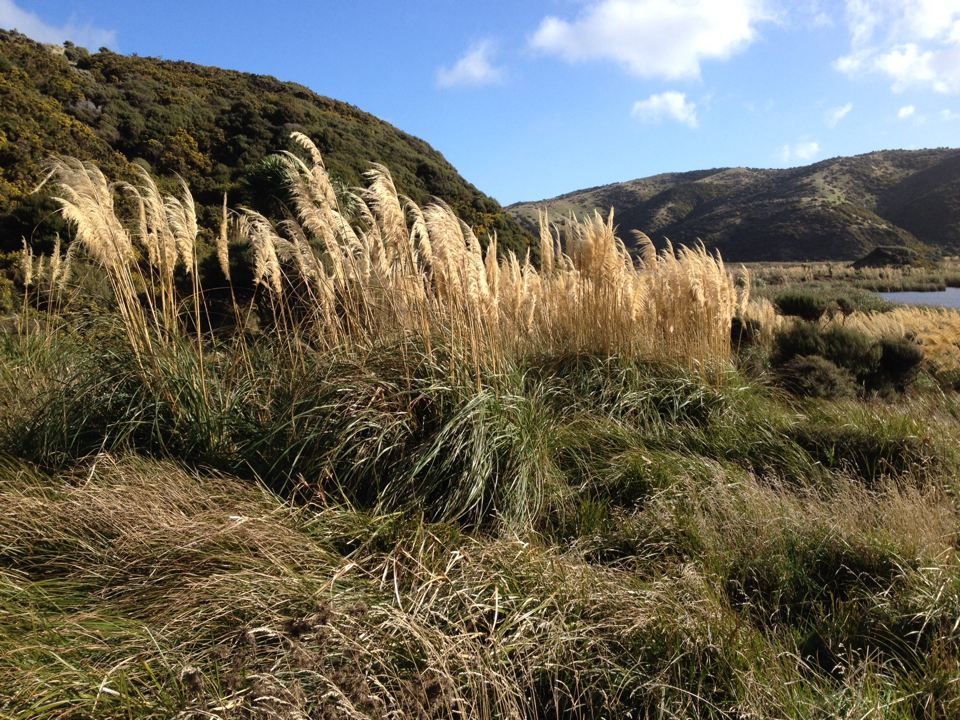Carex secta (Pūrei)
Carex secta
Carex secta, commonly known as pūrei or makura, is one of New Zealand's most distinctive sedges. Its most remarkable feature is the elevated "trunk" formed by densely packed, fibrous old leaf bases and roots, which can raise the growing crown up to a meter above ground level. These natural pedestals, sometimes called "towers" or "islands," are a characteristic sight in wetlands and along waterways throughout New Zealand.
This hardy plant plays a crucial role in wetland ecosystems and has significant cultural importance to Māori, who traditionally used it for various practical and medicinal purposes. Its architectural form and adaptability make it increasingly popular in modern landscape design and ecological restoration projects.

Image credit: Carex secta on Wikipedia
Quick Facts
| Height | 1-2 meters (including trunk) |
|---|---|
| Spread | 1-1.5 meters |
| Water Needs | High |
| Light | Full sun to partial shade |
| Frost Tolerance | High (-5°C) |
| Growth Rate | Moderate |
| Lifespan | 20+ years |
| Flowering | Spring to early summer |
Climate Best Suited To
Carex secta demonstrates remarkable adaptability across New Zealand's diverse climate zones. While naturally occurring in wetlands and along waterways, it can adapt to various moisture conditions once established. Its robust nature allows it to thrive in both cool temperate and warm temperate regions.
| City | Climate Suitability | Notes |
|---|---|---|
| Whangārei | Ideal | Excellent in coastal wetlands |
| Auckland | Ideal | Perfect for urban rain gardens |
| Hamilton | Ideal | Thrives in peat environments |
| Rotorua | Ideal | Excellent in geothermal areas |
| Gisborne | Ideal | Good for riparian planting |
| New Plymouth | Ideal | Perfect in high rainfall areas |
| Napier | Moderate | Needs additional water in summer |
| Wellington | Ideal | Wind resistant |
| Nelson | Ideal | Excellent in coastal wetlands |
| Christchurch | Ideal | Good frost tolerance |
| Dunedin | Ideal | Handles cold well |
| Invercargill | Ideal | Thrives in cool, wet conditions |
Growing Requirements
Soil Requirements
Carex secta demonstrates flexibility in soil conditions but has specific preferences:
- Soil Type:
- Heavy clay to sandy loam
- High organic matter content preferred
- Tolerates poor drainage
- Can grow in standing water
- pH Range:
- Optimal: 5.5-7.0
- Tolerates: 5.0-7.5
- Drainage:
- Poor to moderate drainage acceptable
- Can thrive in permanently wet soils
- Tolerates seasonal flooding
Light Requirements
Light preferences vary by location:
- Natural Habitat:
- Full sun to partial shade
- Tolerates dappled shade
- Best growth in full sun
- Exposure Considerations:
- Morning sun ideal
- Afternoon shade beneficial in hot regions
- Wind tolerant once established
Water Requirements
Water needs vary by season and location:
- Establishment Phase:
- Keep consistently moist
- Daily watering may be needed
- Reduce gradually as roots develop
- Mature Plants:
- Tolerates standing water
- Drought tolerant once established
- Prefers consistent moisture
Uses & Significance
Garden Uses
- Wetland gardens
- Rain gardens
- Water features
- Riparian planting
- Erosion control
- Architectural accent
Cultural Significance
- Traditional weaving material
- Medicinal uses in rongoā Māori
- Historical importance in wetland ecosystems
- Indicator of healthy waterways
Ecological Value
- Habitat for wetland wildlife
- Stream bank stabilization
- Water filtration
- Sediment capture
- Natural flood mitigation
Seasonal Care Calendar
Spring
- New growth begins
- Divide and replant if needed
- Monitor for weed competition
- Check water levels
- Apply slow-release fertilizer if desired
Summer
- Maintain consistent moisture
- Remove any dead foliage
- Watch for signs of drought stress
- Monitor water quality in wetland settings
Autumn
- Clean up fallen debris
- Prepare for winter growth slowdown
- Good time for new plantings
- Check stability of elevated crowns
Winter
- Minimal maintenance needed
- Monitor water levels
- Remove damaged foliage
- Plan spring division if needed
When to Prune and How Much
Carex secta requires minimal pruning but benefits from occasional maintenance:
- Remove dead or damaged leaves at any time
- Cut back old foliage in late winter/early spring
- Trim flowering stems after seed has set if desired
- Avoid cutting into the crown or trunk
- Clean tools between plants to prevent disease spread
When pruning, focus on maintaining the plant's natural form and removing only what is necessary for plant health or aesthetic purposes.
Planting Guide
When to Plant
The best time to plant Carex secta is during spring or autumn when soil moisture is reliable and temperatures are moderate. This gives plants time to establish before extreme weather conditions.
Site Selection
- Choose a site with consistent moisture
- Full sun to partial shade
- Protected from strong winds while establishing
- Allow space for mature size
- Consider water table depth
Planting Procedure
- Prepare the site by removing weeds
- Dig a hole twice the width of the root ball
- Plant at the same depth as it was growing in the container
- Backfill with soil, firming gently
- Water thoroughly after planting
- Apply mulch to retain moisture
Spacing
Space plants 0.8-1.2 meters apart to allow for mature spread. In mass plantings for erosion control, spacing can be reduced to 0.6-0.8 meters.
Propagation
Division
- Timing:
- Early spring optimal
- Autumn possible in warmer regions
- Avoid mid-summer division
- Process:
- Lift whole plant or section
- Cut through crown with sharp spade
- Ensure each division has roots and shoots
- Trim damaged roots and old foliage
- Planting:
- Plant immediately
- Water thoroughly
- Maintain moisture until established
From Seed
- Collection:
- Harvest when seeds turn brown
- Late summer to autumn timing
- Store in cool, dry place
- Sowing:
- Spring sowing best
- Use fresh seed when possible
- Surface sow on moist medium
- Care:
- Keep consistently moist
- Maintain warm temperature
- Protect from strong sun
Cultural History
Carex secta holds significant cultural value in New Zealand:
Traditional Uses by Māori
- Weaving (Raranga):
- Leaves used for fine weaving
- Creation of mats (whariki)
- Basket making (kete)
- Temporary shelters
- Construction:
- Building materials for whare
- Thatching material
- Natural platforms in wetlands
- Temporary bridges
- Medicinal (Rongoā):
- Treatment of skin conditions
- Wound dressing material
- Pain relief applications
Modern Applications
- Environmental:
- Wetland restoration
- Erosion control
- Water quality improvement
- Habitat creation
- Landscape Design:
- Rain gardens
- Water features
- Natural barriers
- Architectural accent plants
Conservation Considerations
Current Threats
- Habitat Loss:
- Wetland drainage
- Urban development
- Agricultural conversion
- Infrastructure projects
- Environmental Pressures:
- Climate change impacts
- Altered hydrology
- Water pollution
- Sedimentation
- Biological Threats:
- Invasive species competition
- Grazing pressure
- Disease susceptibility
- Genetic isolation
While Carex secta remains common, the ongoing loss of wetland habitats threatens natural populations. Conservation efforts focus on habitat protection and restoration.
Bonus Tip
Create dramatic night lighting effects by positioning uplights around mature Carex secta specimens. The elevated form casts interesting shadows, while the arching foliage creates movement in evening breezes. This works particularly well near water features where the light reflects off both the plant and water surface.


